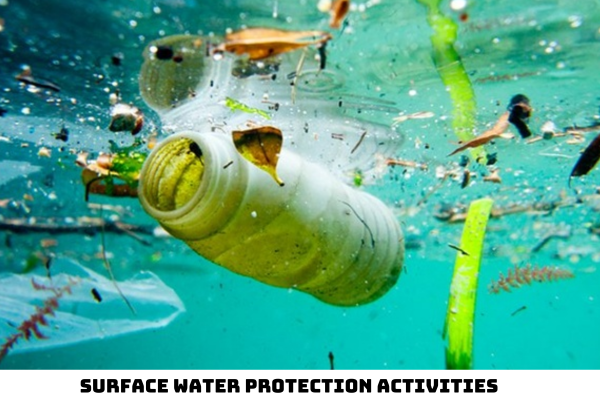Do surface water protection activities in Vietnam include eliminating pollution, remediating, and improving polluted surface water?
- Do surface water protection activities in Vietnam include eliminating pollution, remediating, and improving polluted surface water?
- What are the responsibilities of the Vietnam Ministry of Natural Resources and Environment in surface water protection activities?
- What are the contents of the surface water quality management plan in Vietnam?
Do surface water protection activities in Vietnam include eliminating pollution, remediating, and improving polluted surface water?
Under Clause 1, Article 8 of the Law on Environmental Protection 2020 on surface water protection activities:
Surface water protection activities
1. Surface water protection shall focus on:
a) Statistically reporting, assessing, minimizing and treating wastewater discharged into surface water;
b) Monitoring and assessing quality of surface water, sediment and aquatic environment and publishing information in service of management, extraction and use of water surface;
c) Investigating and assessing carrying capacity of surface water; announcing areas where the surface water has reached its carrying capacity; assessing quotas for discharge of wastewater into the surface water;
d) Eliminating pollution, remediating and improving polluted surface water;
dd) Monitoring and assessing quality of surface water and sediments of international rivers and sharing information in accordance with regulations of law on environmental protection, law and international practice.
...
Thus, one of the surface water protection activities is eliminating pollution, remediating, and improving polluted surface water.

What are the responsibilities of the Vietnam Ministry of Natural Resources and Environment in surface water protection activities?
Under Clause 2, Article 8 of the Law on Environmental Protection 2020, the responsibilities of the Vietnam Ministry of Natural Resources and Environment in surface water protection activities are specified as follows:
Surface water protection activities
...
2. The Ministry of Natural Resources and Environment has the responsibility to:
a) provide guidance on assessing surface water carrying capacity of rivers and lakes; provide guidance on assessing surface water quality;
b) organize assessment of surface water and sediment quality, surface water carrying capacity of inter-provincial rivers and lakes; organize inventorying and assessment of waste sources and pollution level, and organize elimination of inter-provincial river and lake pollution; formulate and submit to the Government a surface water quality management plan for inter-provincial rivers and lakes that play a key role in socio-economic development and environmental protection;
c) inspect the implementation of the surface water quality management plan for inter-provincial rivers and lakes and measures to prevent and mitigate water pollution and improve water quality in inter-provincial rivers and lakes.
...
Thus, in surface water protection activities, the Vietnam Ministry of Natural Resources and Environment shall be responsible for:
(1) Providing guidance on assessing surface water carrying capacity of rivers and lakes; providing guidance on assessing surface water quality;
(2) Organizing assessment of surface water and sediment quality, surface water carrying capacity of inter-provincial rivers and lakes; organizing ing inventorying and assessment of waste sources and pollution level, and organizing elimination of inter-provincial river and lake pollution;
Formulating and submitting to the Government a surface water quality management plan for inter-provincial rivers and lakes that play a key role in socio-economic development and environmental protection;
- Inspecting the implementation of the surface water quality management plan for inter-provincial rivers and lakes and measures to prevent and mitigate water pollution and improve water quality in inter-provincial rivers and lakes.
What are the contents of the surface water quality management plan in Vietnam?
Under Article 9 of the Law on Environmental Protection 2020:
Surface water quality management plan
1. The surface water quality management plan for inter-provincial rivers and lakes must be conformable with the national environmental protection planning.
The surface water quality management plan for the water sources mentioned in Point a Clause 3 Article 8 of this Law must be conformable with the national environmental protection planning and environmental protection contents specified in the regional and provincial planning.
2. Contents of the surface water quality management plan include:
a) Assessments and predictión on trends in changes in surface water quality; objectives and targets of the plan; determining domestic water safeguard zones and water source protection corridors; determining aquatic areas;
b) Current distribution of point source pollution, and non-point source pollution with pollutants released into the water in the affected area; risk of transboundary surface water pollution;
c) Types and total amount of pollutants discharged into the surface water;
d) Assessments carrying capacity, zoning, and quotas for wastewater discharge; determining objectives and roadmap for reducing wastewater discharge into the surface water that has reached its carrying capacity;
dd) Measures to prevent and reduce surface water pollution; solutions for cooperation in, sharing of information and management of transboundary surface water pollution;
e) Solutions for protecting and improving surface water quality;
g) Organization of implementation.
3. The surface water quality management plan is formulated for 05-year periods.
Thus, according to the above regulations, the surface water quality management plan has the following main contents:
- Assessments and predictión on trends in changes in surface water quality; objectives and targets of the plan; determining domestic water safeguard zones and water source protection corridors; determining aquatic areas;
- Current distribution of point source pollution, and non-point source pollution with pollutants released into the water in the affected area; risk of transboundary surface water pollution;
- Types and total amount of pollutants discharged into the surface water;
- Assessments carrying capacity, zoning, and quotas for wastewater discharge; determining objectives and roadmap for reducing wastewater discharge into the surface water that has reached its carrying capacity;
- Measures to prevent and reduce surface water pollution; solutions for cooperation in, sharing of information and management of transboundary surface water pollution;
- Solutions for protecting and improving surface water quality;
- Organization of implementation.
LawNet